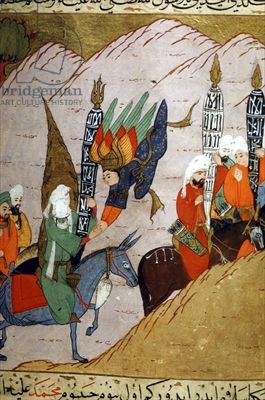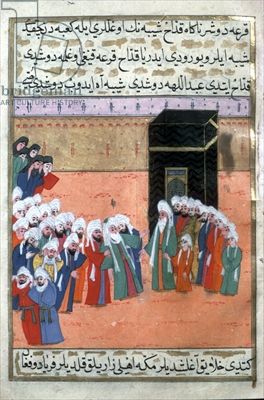Le Met aurait-il peur du Jihad ?
Mohammed's Paradise, Miniature from 'The History of Mohammed', 1030 (gouache & gold on vellum), Persian School, (11th century) / Bibliotheque Nationale, Paris, France / Archives Charmet / The Bridgeman Art Library
NEW YORK (ETATS-UNIS) [13.01.10] – Le Metropolitan Museum suscite la polémique à New York : les vitrines de la galerie d'art islamique se sont vues dégarnir des représentations de Mahomet. Selon le New York Post, ces retraits seraient dus à la volonté du musée d'éviter la controverse avec les musulmans radicaux. Le quotidien s'interroge : le Met aurait-il peur du Jihad ?
A New York, un réaménagement des vitrines au Metropolitan Museum a déclenché une certaine agitation. Des œuvres représentant le Prophète Mahomet ont disparu des vitrines de la galerie d'arts islamiques.
Selon le New York Post, celles-ci pourraient ne pas être présentées après la rénovation de la galerie en 2011.
Pour certains, le Metropolitan Museum cultive depuis longtemps une politique d'évitement des sujets jugés « sensibles » et voudrait éviter par ce retrait une polémique sur la représentation de Mahomet ravivée par la controverse sur les caricatures du prophète au Danemark.
Selon le musée, trois œuvres sont concernées dans cette affaire, des œuvres qui « ne correspondent pas au thème de l'exposition permanente » du moment, selon un porte-parole du musée. De plus, la galerie est en cours de rénovation, et certaines pièces doivent être déplacées, au gré des travaux.
La polémique semble un peu vaine, mais intervient alors que le musée vient d'annoncer un changement de nom de la galerie. « La galerie d'art islamique » va être rebaptisée « galerie des arts des pays arabes, de Turquie, d'Iran, d'Asie centrale et d'Asie du Sud-Est » , une terminologie compliquée que beaucoup taxent de politiquement correct.
Pour Kishwar Rizvi, professeur d'art islamique à l'Université de Yale, ce changement de nom est « une honte » : « il est maladroit et problématique de construire la présentation de ces arts en termes de frontières géographiques » .
Sur la représentation de Mahomet dans les arts, l'historien rappelle que le contexte historique est primordial pour comprendre que les interdictions de représentations ne sont pas dogmatiques et figées dans le monde musulman, des pays arabes à l'Asie du Sud-Est. artclair.com
Ci-dessous quelques représentations :
The Ascension of the Prophet Mohammed, Persian, Islamic School, (16th century) / Seattle Art Museum, Seattle, USA / Giraudon / The Bridgeman Art Library
Mohammed (c.570-c.632) and the Archangel Gabriel, from the 'Siyer-i Nebi' (gouache on paper), Turkish School, (16th century) / Topkapi Palace Museum, Istanbul, Turkey / Bildarchiv Steffens / The Bridgeman Art Library
The Annunciation to Mohammed (c.570-c.632) from the 'Siyer-i Nebi' (gouache on paper), Turkish School, (16th century) / Topkapi Palace Museum, Istanbul, Turkey / Bildarchiv Steffens / The Bridgeman Art Library
Ascent of the Prophet Muhammad to Heaven, Mirak, Aqa (fl.c.1520-76) / British Library, London, UK / © British Library Board. All Rights Reserved / The Bridgeman Art Library
The prophet Mohammed welcoming Jacob in his cave, from 'Zubdet ut Tevarih' by Lokman, 1583 (vellum), Turkish School, (16th century) / Topkapi Palace Museum, Istanbul, Turkey / The Bridgeman Art Library
The Archangel Gabriel inspiring Mohammed in the mosque of medina (gouache on paper), Ottoman School, (18th century) / Museum of Turkish and Islamic Art, Istanbul, Turkey / Photo © AISA / The Bridgeman Art Library
The Death of Mohammed (c.570-c.632) from the 'Siyer-i Nebi' (gouache on paper), Turkish School, (16th century) / Topkapi Palace Museum, Istanbul, Turkey / Bildarchiv Steffens / The Bridgeman Art Library
The Archangel Gabriel inspiring Mohammed in the mosque of medina (gouache on paper), Ottoman School, (18th century) / Museum of Turkish and Islamic Art, Istanbul, Turkey / Photo © AISA / Bridgeman Giraudon
Mohammed (c.570-c.632) praying before the Kaaba in Mecca, from the 'Siyer-i Nebi' (gouache on paper), Turkish School, (16th century) / Topkapi Palace Museum, Istanbul, Turkey / Bildarchiv Steffens / Bridgeman Giraudon
Mohammed (c.570-c.632) before the Kaaba in Mecca, from the 'Siyer-i Nebi' (gouache on paper), Turkish School, (16th century) / Topkapi Palace Museum, Istanbul, Turkey / Bildarchiv Steffens / Bridgeman Giraudon
Mohammed (c.570-c.632) and the Archangel Gabriel, from the 'Siyer-i Nebi' (gouache on paper) (detail of 251911), Turkish School, (16th century) / Topkapi Palace Museum, Istanbul, Turkey / Bildarchiv Steffens / Bridgeman Giraudon
Mohammed (c.570-c.632) is chosen by the Archangel Gabriel, from the 'Siyer-i Nebi' (gouache on paper), Turkish School, (16th century) / Topkapi Palace Museum, Istanbul, Turkey / Bildarchiv Steffens / Bridgeman Giraudon
Mohammed (c.570-c.632) between his wife Khadija and his nephew Ali, from the Siyer-i Nebi (gouache on paper), Turkish School, (16th century) / Topkapi Palace Museum, Istanbul, Turkey / Bildarchiv Steffens / Bridgeman Giraudon
Mohammed (c.570-c.632) and his entourage in discussion with soldiers, from the 'Siyer-i Nebi' (gouache on paper), Turkish School, (16th century) / Topkapi Palace Museum, Istanbul, Turkey / Bildarchiv Steffens / Bridgeman Giraudon
The Ascension of Mohammed, from the Khamsa of Elyas Nezami (1140-1209) 1504 (vellum), Islamic School, (16th century) / Private Collection / Giraudon / Bridgeman Giraudon
Mohammed (c.570-c.632) with his faithful followers on the way to Mecca, from the 'Siyer-i Nebi' (gouache on paper), Turkish School, (16th century) / Topkapi Palace Museum, Istanbul, Turkey / Bildarchiv Steffens / Bridgeman Giraudon
The archangel revealed to the prophet Muhammad from the 8th surah of the 'Quran', page of the 'Siyar-i-Nabi', 1594-5, Turkey, (literary text), (gouache and gold on paper), / Louvre, Paris, France / Bridgeman Giraudon
The faithful before the Kaaba in Mecca, from the 'Siyer-i Nebi' (gouache on paper), Turkish School, (16th century) / Topkapi Palace Museum, Istanbul, Turkey / Bildarchiv Steffens / Bridgeman Giraudon

/https%3A%2F%2Fprofilepics.canalblog.com%2Fprofilepics%2F1%2F0%2F100183.jpg)
/https%3A%2F%2Fstorage.canalblog.com%2F03%2F02%2F119589%2F96711876_o.jpg)
/https%3A%2F%2Fstorage.canalblog.com%2F11%2F31%2F119589%2F94773502_o.jpg)
/https%3A%2F%2Fstorage.canalblog.com%2F20%2F83%2F119589%2F94772815_o.jpg)
/https%3A%2F%2Fstorage.canalblog.com%2F26%2F72%2F119589%2F75604929_o.jpg)
/https%3A%2F%2Fstorage.canalblog.com%2F59%2F60%2F119589%2F26458628_o.jpg)





















/http%3A%2F%2Fstorage.canalblog.com%2F41%2F70%2F119589%2F71222445_o.jpg)
/http%3A%2F%2Fstorage.canalblog.com%2F84%2F50%2F577050%2F40250600_p.jpg)
/image%2F1371349%2F20240416%2Fob_65a1d8_telechargement-31.jpg)
/image%2F1371349%2F20240416%2Fob_3b1c51_telechargement.jpg)